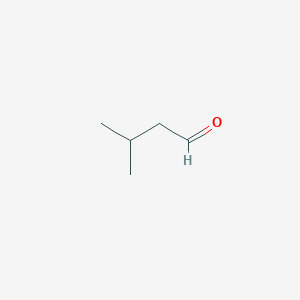| General Information of MET (ID: META00567) |
| Name |
Isovaleraldehyde
|
| Synonyms |
Click to Show/Hide Synonyms of This Metabolite
2-Methylbutanal-4; 3-Methyl-1-butanal; 3-Methyl-butanal; 3-Methyl-butyraldehyde; 3-Methylbutan-1-al; 3-Methylbutanal; 3-Methylbutyraldehyde; Isoamyl aldehyde; Isoamylaldehyde; Isopentaldehyde; Isopentanal; Isovaleral; Isovaleraldehyde; Isovaleric aldehyde; Isovalerylaldehyde; Methyl butanal; beta-Methylbutanal; iso-C4H9CHO; iso-Valeraldehyde
|
| Source |
Food;Yeast Metabolite;Food;Cosmetic;Food additives;TCM Ingredients;Microbial
|
| Structure Type |
Carbonyl compounds (Click to Show/Hide the Complete Structure Type Hierarchy)
Organic oxygen compounds
Organooxygen compounds
Carbonyl compounds
|
| PubChem CID |
|
| HMDB ID |
|
| Formula |
C5H10O
|
| Structure |
<iframe style="width: 300px; height: 300px;" frameborder="0" src="https://embed.molview.org/v1/?mode=balls&cid=11552"></iframe>
|
 |
|
3D MOL
|
2D MOL
|
|
Click to Show/Hide the Molecular/Functional Data (External Links/Property/Function) of This Metabolite
|
| KEGG ID |
|
| ChEBI ID |
|
| FooDB ID |
|
| ChemSpider ID |
|
| Physicochemical Properties |
Molecular Weight |
86.13 |
Topological Polar Surface Area |
17.1 |
| XlogP |
1 |
Complexity |
39.2 |
| Heavy Atom Count |
6 |
Rotatable Bond Count |
2 |
| Hydrogen Bond Donor Count |
N.A. |
Hydrogen Bond Acceptor Count |
1 |
| Function |
Isovaleraldehyde is an oxygenated (aldehyde) volatile organic compounds (VOC), normally found in humans, particularly in the gut. Isovaleraldehyde is a leucine degradation product that has been found in elevated concentrations in some cases of hepatic encephalopathy, however not significantly. Fermentation of carbohydrates in the gut produces ethanoic, propionic, butanoic, pentanoic, and hexanoic acid acids, particularly by Bacteroides, although some of the isovaleraldehyde may be of dietetic origin. Isovaleraldehyde is a normal component of the chemical profile of cheddar cheese and spirits (beer, rum, sake, wine).
|
|
Regulatory Network
|
|
|
|
|
|
|
|
|
 click to show the details of this protein
click to show the details of this protein
 click to show the details of experiment for validating this pair
click to show the details of experiment for validating this pair

